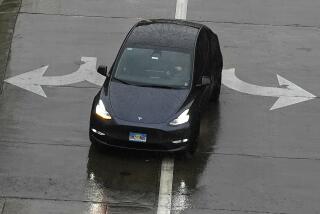Solyndra’s collapse is a tale of too much dazzle
It was the better mousetrap.
From Silicon Valley to the White House, Solyndra’s unique solar panels left everyone gasping for a piece of the action.
Analysts gushed over the cylindrical design, so much more exciting than the dull, flat panels coming out of China. Company executives promised huge revenue, supporting thousands of permanent jobs, while a stream of state and federal politicians toured the Fremont plant, basking in what felt like the glow of the future.
Investors, convinced that Solyndra was the big one, the harbinger of a solar boom, poured more than $1 billion into the company, with the U.S. government guaranteeing 50% more in loans.
Then suddenly, the bottom dropped out last month. In a matter of days, Solyndra ceased operations, plunged into bankruptcy, was raided by the FBI and found itself thrust into a national political firestorm.
Nearly all the attention in the Solyndra case has revolved around the Obama administration’s $528-million bad bet, with partisan congressional finger-pointing growing increasingly nasty. But in many ways, Solyndra’s tale is one of irrational exuberance, a collective belief unswayed by blown sales projections, yanked IPOs, shuttered factories and fired executives.
Almost to the end, private investors continued to pump millions into the company. Officials in Sacramento; Madison, Wis.; and other statehouses, thrilled to see jobs being created in a terrible economy, extended the public’s largesse, offering sales tax breaks and loan guarantees to Solyndra suppliers.
And when the balance sheet got really grim, everyone doubled down.
Whether corporate managers issued misleading financial information or covered up growing problems remains to be determined as federal authorities probe the company, which fired its roughly 1,100 employees on the last day of August and filed for Chapter 11 protection Sept. 6.
But to grasp the saga of Solyndra’s rapid rise and even faster fall, one has to understand the dazzling appeal of its product. The company’s advancement in solar power was hailed as an invention so brilliant that it blinded everyone to the truth: Solyndra never had much of a chance in a fast-changing market.
“It was revolutionary,” said Walter Bailey, a former Macquarie Capital investment banker who specialized in green technology and visited Solyndra in 2008. “You had some of the smartest money in the world getting behind it. It was a real company with a huge factory and an extremely unique product.
“The only problem,” said Bailey, now a senior partner at boutique investment bank Focus Capital in New York, “was that it never penciled out.”
Unlike the increasingly ubiquitous flat solar panel, Solyndra’s design completely rethought the process of turning sunlight into electricity, creating a product perfect for flat roofs of warehouses, supermarkets and other commercial buildings.
Its rectangular panels, called modules, are made of dozens of horizontally arrayed cylindrical tubes — hence the name Solyndra. As the sun tracks across the sky, the curved surfaces stay perpendicular to its rays all day, unlike conventional flat panels. And light reflecting off the roof hits the underside of the tubes, increasing production.
In addition, Solyndra’s product weighs much less than flat panels and is far simpler to install. Best of all, said Laura Weilert, a Denver solar engineer, is the way the modules let air circulate through them.
“Wind tends to pull every other kind of panel off a building, but not Solyndra,” said Weilert, who has installed Solyndra modules on about 170 buildings in Colorado and had $300,000 of additional modules on order when the company shut down. “For the right market, it’s hands down the best thing out there.”
Solyndra’s founder, Chris Gronet, invented the panels and left his job as an executive at Applied Materials Inc., a major supplier to high-tech companies such as IBM Corp., Samsung Electronics Co. and Texas Instruments Inc., to focus on solar full time.
He formed his own company in 2005 and lured investors with another selling point of his modules — the fact that they didn’t use silicon, an essential and expensive component of conventional solar cells.
By early 2008, the price of high-grade silicon had reached almost $1,000 a pound, nearly 10 times what it had been just a few years earlier. Venture capitalists raced to get in, making Solyndra one of the hottest bets in Silicon Valley at a time when solar was rapidly expanding in the U.S. and Europe thanks to government subsidies.
“They were considered very exciting,” said Shayle Kann, managing director of consulting firm GTM Research’s solar practice. “They had the potential to substantially reduce solar costs at the time, and they had attracted an enormous amount of private investment.”
One investor, British billionaire Richard Branson’s Virgin Green Fund, bragged that it had selected only Solyndra from a pool of 117 solar companies seeking backing. Other investors included billionaire Oklahoma oil baron George Kaiser, and a fund that manages the money of the family behind Wal-Mart Stores Inc. Wall Street heavyweight Goldman Sachs Group Inc. was its lead investment banker.
“Very high-profile money was all over that company,” said Bailey, the investment banker. “Nobody else had anything as strikingly different as Solyndra.”
When the company emerged from what it called “stealth mode” in October 2008, it had already raised $600 million and was the toast of Silicon Valley. It also had applied for the Department of Energy loan guarantee, which would be granted in 2009.
That guarantee, the first approved in the program, made Solyndra a symbolic standard-bearer for the Obama administration’s push for investing in green jobs.
Under terms of the deal, the Energy Department would guarantee the loan, issued by the Treasury’s Federal Financing Bank and carrying a tiny 1% interest rate. The money would pay the lion’s share of a new $733-million factory, the company’s second, needed to increase capacity dramatically and streamline manufacturing.
That was key, the company said, because it urgently needed to bring costs down.
By the time the loan was conditionally approved, sinking demand for solar energy had helped drive the price of silicon off a cliff, to less than $100 a pound. Heavily subsidized Chinese flat-panel makers began slashing prices faster than Solyndra could.
Solyndra’s prices were 66% higher than competing flat panels in late 2009, according to public documents filed with the Securities and Exchange Commission.
What’s more, Solyndra was selling them for almost half what they cost to make in an effort to build market share, which only led to mounting losses.
The company never made a profit. By 2009, the company had lost $373 million. Less than a year later, losses grew to $558 million, enough to get auditor PriceWaterhouse to issue a stark warning about Solyndra’s financial viability.
Solyndra argued, however, that it could get its prices down if it could just buy more time. The company pointed to successes such as a 3-megawatt installation in Belgium and a 500-kilowatt Costco Wholesale Corp. rooftop in New Jersey that won a national solar award. Even as the company was losing millions, the Wall Street Journal ranked it the top clean-tech company in the country.
“It was a really nice technology,” said Mike Anderson, vice president for marketing at Solar Power Inc., which installed Solyndra panels on the Costco in Hazlet, N.J.
In mid-2008, his firm inked a deal with Solyndra to buy up to $325 million of its modules. But with prices falling much faster for other types of panels, Solar Power completed only one other project using the technology.
“It just didn’t get to a point where it could compete,” said Anderson, pointing out that the much lower cost of conventional panels outweighed the design advantages of Solyndra’s product.
Meanwhile, more red flags kept popping up.
Just weeks after President Obama visited Solyndra’s factory in May 2010, touting the permanent jobs it had created, Solyndra yanked a planned $300-million initial public offering. Soon thereafter, it named a new chief executive — who had no experience in solar panels.
The turmoil spurred an exodus of talent, according to Michael Kohlstadt, a research and development engineer who worked at Solyndra for four years before being laid off Aug. 31.
He had dreamed of cashing in his 13,000 stock options for as much as $250,000, but now is left with a lawsuit against the company for unpaid vacation time owed when Solyndra shut down.
“They were still hiring people the prior week,” Kohlstadt said.
In the year and a half before its collapse, the company was able to raise $175 million in private loans, despite the continuing stream of alarming news. In February, the administration allowed Solyndra to take $75 million in additional outside loans that would take priority over its own debt, a desperation move that put taxpayers behind private equity firms in terms of getting repaid.
Behind the scenes, the company was pumping nearly $2 million into a lobbying effort designed to present a positive face to the government.
As late as July, the company sent a barrage of upbeat information to politicians, claiming that it was financially “on track” and “at pace with the industry” in terms of cost-cutting.
In California, the efforts paid dividends.
Last November, just two weeks after Solyndra shuttered its original factory and laid off 150 workers, the California Alternative Energy and Advanced Transportation Financing Authority authorized up to $34.7 million in sales tax exemptions for the company.
Christine Solich, the authority’s executive director, said it did not factor Solyndra’s viability into the equation.
“Financial sustainability wasn’t something we were required to review,” said Solich, who said she toured the company in June and admitted being impressed by the high-tech robotic forklifts and other advanced machinery.
By the time it had folded, she said, Solyndra had redeemed about $25 million of the tax exemptions.
Wisconsin, too, got into the act. Last October, it served up a $3.75-million, zero-interest loan to MGS Manufacturing Group, which made plastic harnesses for Solyndra’s modules. The loan was contingent on MGS creating 168 full-time jobs based on sales to Solyndra.
“It’ll be difficult for us to have the number of people that were forecast” with
Solyndra out of business, said John Berg, marketing director for MGS Manufacturing.
Damien LaVera, a spokesman for the Energy Department, argued that the government made a measured decision, one based on the tremendous potential of the Solyndra technology. The PriceWaterhouse warning, for example, he dismissed as “precisely the kind of review that would be typical of a high-tech startup company.”
“Solyndra appeared to be well-positioned to compete and succeed in the global marketplace,” said LaVera, whose agency ultimately turned Solyndra down for a second loan guarantee, worth $469 million.
He noted that revenue increased 40% from 2009, to $140 million last year, but acknowledged that the growth was far below prior company projections. “The reason they went bankrupt is the changes in the solar market.”
Solyndra spokesman David Miller, who argued that the company had a chance for success until flat solar panel prices fell even further this year, said at least two potential buyers had stepped forward.
If they don’t buy, however, the transformative concept of a cylindrical solar panel could die along with the company, analysts
said.
That could leave a lot of projects in the lurch, including a 16.2-megawatt deal that Southern California Edison cut with Solyndra in mid-2010 to put its panels on 15 buildings throughout California. The project was to be Solyndra’s largest ever, yet nothing was installed by last spring’s deadline.
“I didn’t know that the end was coming” for Solyndra, said Marc Ulrich, vice president of renewable and alternative power at the utility. But then again, he said, he wasn’t too surprised to see yet another solar effort die.
“We know this market,” Ulrich said. “We always assume that about 40% of these projects will end in failure.”
Bensinger and Pfeifer reported from Los Angeles and Banerjee from Washington.
More to Read
Sign up for Essential California
The most important California stories and recommendations in your inbox every morning.
You may occasionally receive promotional content from the Los Angeles Times.












